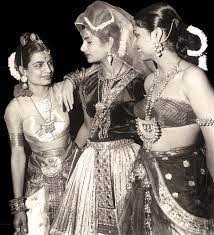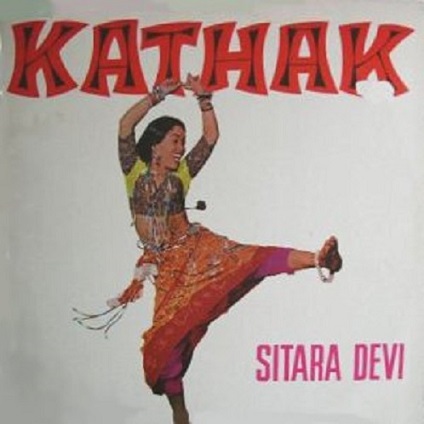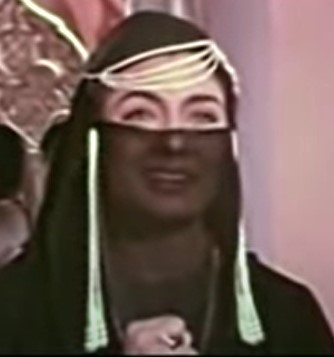
The still above, taken from Dholak (1951), is sort of a false beginning to this post. I am starting off with this picture because I would have liked to post about Indian female drummers from the early ’50s, which would have fit well with most of the things that I post on this blog these days. But as it turns out, I couldn’t find any female Indian drummers from the 1950s. Though all the drummers in the film scene are women, I would bet that the playback drummers were men. (Also, the part of the song that actually focuses on the drumming is quite small and the rest of the song is something else entirely, which would have stood out in this post like a proverbial sore thumb – which is why I’ve decided not to post the whole song.)
I can only conclude that back in the old days, there were no female Indian drummers. I could be wrong and I would like to know if I am but it seems that there were some pretty strong taboos about women playing percussion on the Subcontinent. For the most part, they were not allowed into that musical tradition, and that is why I have ended up writing a different kind of post.
So for this post, I’m going to take (another) one of my occasional trips out of the past, to focus on some great contemporary female players of Indian drums. But even now, it seems difficult to find female drummers who actually live in India. In fact, none of the women I’m posting about here come from India, and one doesn’t even have Indian heritage. Maybe even in recent times, it has been necessary for most of these taboo-breakers to come from a place far away from India or Pakistan. That is one reason I have not called this post “Indian female drummers.” They are not necessarily Indian female drummers, but they are women playing Indian drums.
I know about a few more than the ones mentioned here, but I wanted to share my enthusiasm for these three artists in particular. The first one I wanted to talk about is someone who’s appeared in this blog before, Aminah Chishti, also known as Jessica Ripper, the drummer for Fanna-Fi-Allah Sufi Qawwali. Jessica’s story is quite remarkable. Originally from California, where she still lives for part of the year, she converted to Sufi Islam and became the first female tabla player granted permission to play in the great Sufi shrines in Pakistan. But obviously, she is far from Indian or Pakistani in heritage.
In the prior post where I talked about Aminah, I included some good information about her as well as a few great video clips. But now I have a couple more things to add… For one thing, there is a newer YouTube video that highlights her tabla talents beautifully:
In the prior post, I also included a trailer for a film called Beneath the Veils. The clip below is a longer version, which I take to be the complete short film – although it is also part of a larger documentary, which hasn’t come out yet (as far as I know). This short film is much more about qawwali than about tabla playing, but it’s also a great autobiographical introduction to and by Aminah, herself.
Suphala is a tabla player and composer who hails from my town, New York City. But she is the daughter of Indian-born parents, and she has been learning both Indian and Western forms of classical music from a very young age. Her classical tabla training has included two very impressive musicians, Ustad Alla Rakha and Zakir Hussain. (By the way, I saw Zakir Hussain live a while back, and he certainly was good!) And Suphala’s public tabla performances have included not only concerts with traditional musicians but also collaborations with a wide range of well-known pop music artists, including Yoko Ono, Norah Jones and Edie Brickell.
I looked at a bunch of videos by Suphala, and I think my favorite might be this one, in which she collaborates with several guys playing a variety of other Indian percussion instruments. I don’t know much about this and can’t really find out much, either. I just know that I really like it.
And here is a very nice Suphala solo. I hope she’ll do solos like this when I see her live (which will be soon, probably this coming September).
Since I started this post with a picture of a group of women playing the dholak, I thought it would be fun to conclude with someone who’s the queen of the similar, larger instrument called the dhol. Rani Taj is marvelous. She first became noticed by the world through a YouTube video of her playing her dhol to a pop song by Rihanna in the streets of the UK in 2010, when she was 17 years old. (She is a native of Birmingham, England, although her parents came from Kashmir.) In more recent times, she has concentrated much more on playing traditional Indian/Pakistani music, especially within the Sufi tradition. So like Aminah Chishti, Rani Taj also has good connections to the subject that I wrote about last month, the celebrations of Lal Shahbaz Qalandar. And here’s something to prove that point:
[Note from below the YouTube post: Shoulder to shoulder with Ustads Gunga and Mittu Sain, Rani Taj performs at the Jashan e Sham e Qalandar 2012.]
Rani Taj is not only a good dhol player but a good educator as well, as she shows in this video made in a radio studio in New York. After a nice modern bhangra session, she explains and demonstrates different styles played on the dhol, including the Indian and Sufi dhamals.
I like ending this post in an educational way, but in addition to learning a little about styles and traditions, it would be nice to get a little more history. If anyone does know about women who played Indian drums in days of yore, please let me know, and I’ll be happy to add the info here. Meanwhile, I am still glad to grace this blog with these excellent contemporary musicians.




Slightly off topic. Perhaps this author may know http://www.drummagazine.com/features/post/when-the-drummers-were-women/
Firstly,Tansen-ique shall always be obliged to grace the page with your posts which are so rich with celebration, spirit of inquiry and importantly to bring forth forgotten days of music, musicians, songs and styles.You will surely whet the curiosity of the keen and serious,add joy in the readings of the fun seekers and surely surprise the many like me who are completely unaware of the breadth, range , evolution and development of tools of entertainment.You have stimulated me to seek for more and find something to add if I can. Setting out then…..
Swarup, thank you for the article link. I think I’ve seen that before but never got around to reading it. That was interesting. I don’t know if the author would know anything about Indian drummers, because she doesn’t say a word about Indian drums except in a brief reference to the different kinds of drums her teacher had played (unless I missed something here)… But her descriptions of the religious/ecstatic drumming rituals in the ancient world (meaning Greece and Rome) bear a strong resemblance to descriptions of drumming in Sufi rituals, and her description of the greater variety of sounds achieved by playing the frame drum with bare hands matches things I’ve read about the great variety of sounds that people can play with hands and fingers on the tablas.
It is interesting that the drummers were exclusively or mainly women for thousands of years. The author of the article blames Christianity for changing that (completely), but it must have been a social change that extended well beyond Christianity. I got the impression that there were taboos against women joining the drumming groups in India which extended back well before the Christian colonizers arrived. I would guess that at one time India always had female drummers also, but we can’t really get an answer to that question from this article.
Sunil (Wingedream), as I said over in your great Facebook group called Tansenique, I once again feel very encouraged by your nice words, and good luck with your search. I look forward to seeing anything that you can find, but if you don’t find anything, that’s fine, too, because I am certainly happy enough with the comment that you already contributed. :)
Richard, I thought that since she referred to one Glen, who learnt drums from Soth Indians among others, she might know. Anyway, there are some female drummers in Indian sculptures at various times. But I do not know how frequent it was and whether it disappeared completely at any stage.
Some here http://przmm.blogspot.com.au/2012/07/supreme-dancersilent-musicians.html by random Google search
This is supposed to be an ancient form which is still practiced https://youtu.be/HhoS8el2JS0
Those are very nice sculptures, and I like the performance, too. I think these would fit in with the woman-centered drumming rituals from the ancient world that Layne Redmond wrote about in that Drum Magazine article.
I was really wondering if there were any female drummers, say, in the mid-20th Cenutry who might be the type who would be called upon to do drumming in a film. The scenes from Dholak (1951) seem to be a fictional representation of something that didn’t generally exist – that is, women playing drums in popular bands at the time. All the women whom I mentioned above talked about how they were breaking some kind of taboo against female drummers – or, if not exactly breaking a taboo, then at least doing something that people in different circles were not used to seeing women do.
I’m reminded of some material I read about the famous sarod player Sharan Rani. I first saw her name in a nice little illustrated book that I found about 10 years ago in a thirft store in Ithaca, NY, selling for about 30 cents. :) Sharan Rani has been mentioned in some places as the first Indian woman to become a world-famous musician. She started getting a reputation in India in the ’30s and got worldwide recognition in the ’50s (the same time as the Vintage and Golden age in Indian films). I understand that it was particularly unusual for her to master the sarod, because it was simply not considered a “woman’s instrument.” I haven’t seen a lot of women who were famous in the mid 20th century for anything to do with music outside of singing and dancing. (And as we know, female dancers were also not so accepted in “respectable” society in the 19th and early 20th centuries.) So, anyway, it would be interesting to find out if there were any women who managed to break through – or even just get gigs – as drummers during the Golden/Vintage era of films. As far as I know, there weren’t any. But since we saw women drummers in films like Dholak, I suppose it wasn’t unthinkable? (I have seen a few scenes in films made after the mid ’50s of women playing modern western drums – one with Helen comes to mind right away. But Helen often represented an exotic, non-Indian woman, and she wasn’t playing an Indian drum. :) )
Richard, This won’t address your main questions. But I remember some from Tamil films of 1940s. I do not know how systematic they were or whether there were differences between North and South.
There is a more popular one from 1941
Those are very charming! I like the first one especially. I should get more into South Indian films and scenes again…
Re. Hindi films, these reminded me of the scenes with all the female musicians in Sargam (1950), but those actually have a man or boy playing the drums, with the women playing the string instruments.
Now, the question is, are the women on the screen really playing the instruments, or is someone else dubbing it in? I know that in the early ’40s, it was always much more likely for the singer to be on screen and playback techniques weren’t used as often, but I don’t know if that applies as much to the instruments as the voice.
Thank you to Sidharth Bhatia, who saw a link to this to this post that I’d shared on Facebook and sent me a link to the Web site of Anuradha Pal. She is a tabla player residing in Mumbai, who, according to her biography, was “hailed as the First Professional female Tabla Virtuoso in the world by the prestigious Encyclopedia Britannica, Who‘s Who journal of the World & Limca Book of Records (1991).” Of course, if the first professional female tabla virtuoso in the world was recognized in 1991, this would explain why I have not found any from the 1950s. Still, she predates the ones I wrote about above by a few years,
Anuradha Pal was taught tabla by Alla Rakha and Zakir Hussain, so she has something big in common with Suphala, too.
Here’s a good video of one of her solos:
The all-female group called Sakhi has two female drummers who play on a regular basis. Savani Talwalkar plays the tabla and Mahima Updadhyay plays the pakhawaj. Check this link youtube.
Bits of information here
http://www.livemint.com/Leisure/sG8x5YeI0XEdCA8278CIpN/Musicians-from-100-years-ago.html
The first of the photographs here may be the one mentioned above http://tasveerjournal.com/2014/04/22/the-beauties-of-lucknow-2/
Thank you to Soumya Banerji for the latest music clip. There really are quite a few talented female players of Indian percussion being brought out in the present day. It’s nice to see someone playing the pakhawaj; that’s a little different. I see that these musicians were brought together by Kaushiki Chakrabarty… I certainly have heard her singing a few times, might even have her voice on some MP3s.
Swarup, thanks for the interesting articles. The first one, from Livemint, certainly answers one of my question with this statement:
The existence of this photograph, however, establishes the fact that both tabla and sarangi were played by professional female performers in the 19th century, if not earlier. Later claims by women tabla artistes declaring themselves the first in this regard are also proved incorrect by this photograph.
Yes, the picture at the top of the Tasveer Journal‘s “Beauties of Lucknow” article might the one mentioned in the Livemint article… I may have seen this a while back (maybe recommended by you before?). The pictures are impressive. The text tells the familiar tale about the ignorant British imperialists who had no understanding of the courtesans and their rich traditions.
Richard, Thanks to your interesting posts and questions, I am learning a bit more about the historical background of some of these arts. Sorry for the repeat. Please delete one of them. Thanks
Swarup, thank you for the nice words above. Per your request, I have consolidated your last few posts so that there are no repeats now. (Although I don’t mind when you repeat, because your links are always worth repeating. :) )
The second painting from 17th century http://scroll.in/article/820371/when-a-hindu-ruler-commissioned-a-muslim-painter-to-recreate-the-ramayana
Swarup, thanks for adding this as a follow-up several months later. It’s nice that you remembered! I’m looking over these comments to make the connections again. Very interesting…